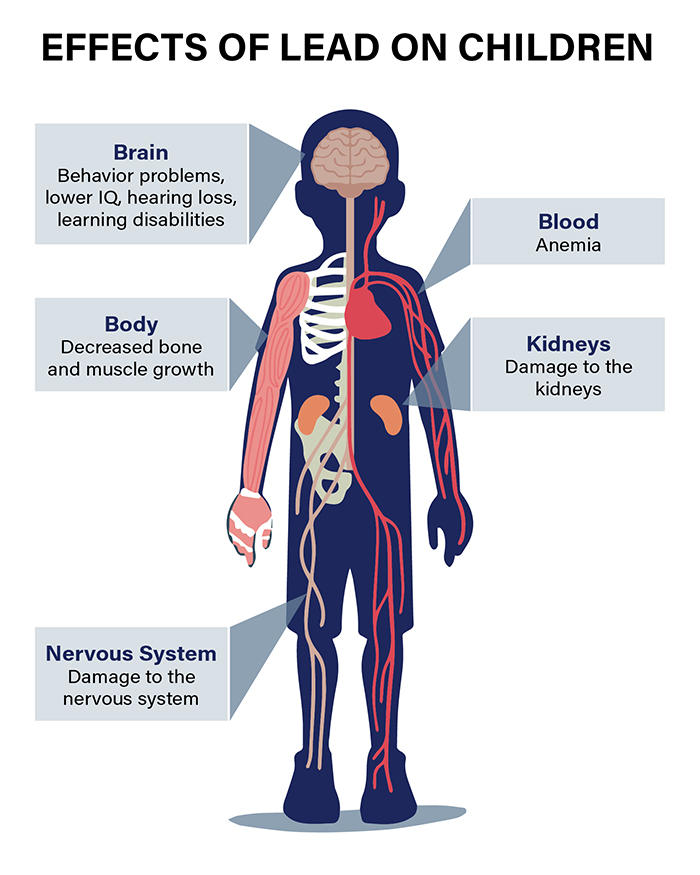
Health Effects of Lead
What is the City of Houston Doing to Protect Customers?
The City treats the drinking water from the main water system, Kingwood, Willowchase, District 73, District 82 and Belleau Woods according to federal and state standards to remove harmful contaminants. When water leaves the treatment plants, it does not have lead. Lead can enter drinking water when it travels through water service lines that contain lead and/or your home or building's internal plumbing.

Health Effects of Lead
According to the EPA, no safe level of lead can be consumed or ingested.
Prolonged lead exposure can lead to health problems. Pregnant women, young children and elderly adults are most affected. In pregnant women, lead can be passed to the fetus through the placental membrane leading to premature birth and reduced growth. In children, low levels of lead exposure have been related to damage to the central and peripheral nervous system, learning disabilities, shorter height, impaired hearing, and impaired blood cell formation and function. For adults, high levels of lead exposure can cause damage to the kidneys, brain, and the nervous system, and affect the production of red blood cells that carry oxygen to all parts of the body.
If you have a lead or galvanized water service line, the lead from your pipe may leach into the water you drink. The EPA estimated that 10 to 20% of lead exposure in young children may come from drinking water. Infants who drink formula made with lead-containing water can get 40 to 60% of their lead exposure from drinking water. Humans do not absorb lead through the skin, so you do not need to filter your shower and bath water for lead.
If you are concerned about lead in your drinking water, visit the EPA's Basic Information about Lead in Drinking Water webpage or follow the steps below to reduce your exposure.

More Information
Lead and Copper Rule Revisions
Water Service Line Inspections
Water Service Line Inventory Map
Health Effects of Lead
Test Holing for Material Verification
Water Service Line Material Letters
School and Childcare Sampling
FAQs and Additional Resources
For information or inquiries email:
- 311 (713) 837-0311
- 311@houstontx.gov
How to Reduce Your Exposure to Lead in Your Drinking Water
If you think you may have a lead or galvanized steel water service line, you can take the below steps to decrease your lead exposure:
- Replace your lead or galvanized steel water service line. If you have a lead water service line, you can hire a licensed plumber or contractor to replace your line. Please let the City know when you are replacing your line so we can also replace our portion of the water service line.
- Before drinking water or making baby formula, take a shower, do laundry, or do a load of dishes to flush the pipes. Showering and flushing the toilet will help clear out your water service line if water has gone unused for more than 6 hours. This flushes the standing water and brings fresh water from the water main line. You can also run the tap for a short period of time, depending on the size of the property and the length of the water service line.
- Use cold water for cooking, drinking, and making baby formula. Lead dissolves into hot water more easily than cold water. If you need hot water, draw cold water and then heat it. It is safe to shower, wash dishes, and do laundry with hot water. Boiling water does not remove lead.
- Replace your home's internal plumbing that may have lead. Potential lead sources include lead pipes, lead-based solder, and brass fixtures and valves (including faucets). When buying new plumbing fixtures (faucets, valves, sinks, hose bibs, etc.), choose those that have zero-content meeting current "lead-free" requirements. Read the labels of new plumbing fixtures closely.
- Remove and clean faucet strainers. Every 3 months, remove and clean strainers at the tip of faucets to remove build up.
o Remove the faucet strainers from all taps.
o Rinse the faucet strainers.
o Run the water without a strainer for 3 to 5 minutes.
o Replace faucet strainers
- Test your water for lead. You can test your water for lead using a state-approved laboratory. If the test shows a value above 0.010 milligrams per liter, contact the City of Houston for additional information on how best to protect yourself and your family. Click this link to view the list of state approved laboratories.
- Use filters. Consider using a water filter. Be sure the filter you choose (faucet and/or pitcher filter) is approved to reduce lead (NSF 53/42-certified for lead removal). Visit this link to learn more about water filters.
- Test your child's blood for lead. Your local doctor or pediatrician can perform a blood test for lead and give you information about the health effects of lead. Visit the Texas Department of State Health Service's website to learn more, including where you can test your child's blood.
Visit the EPA's webpage about reducing lead in drinking water to learn more.
